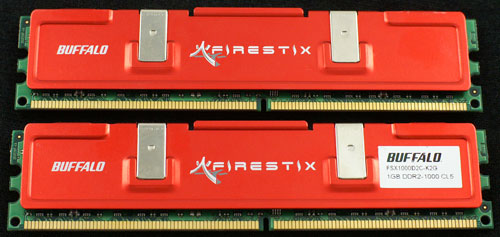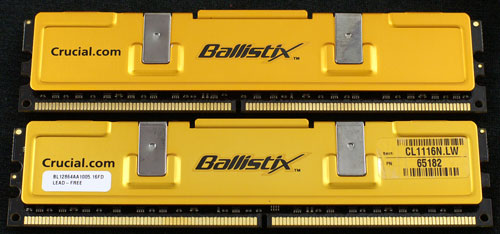High Speed DDR2: Buffalo and Crucial Deliver 1000+
by Wesley Fink on July 7, 2006 12:05 AM EST- Posted in
- Memory
Buffalo FireStix Product Specifications and Information
Buffalo Technology has become a well known manufacturer of memory, wired and wireless network products, and storage solutions. You will find a full range of Buffalo memory products available from many on-line resellers, including regular DIMMs, SO-DIMMs, and Registered memory for servers, desktop computers, and notebooks. Buffalo may not be the first name that comes to mind when Enthusiasts are looking for high-performance memory, but Buffalo has a successful line of Enthusiast products marketed under the FireStix name.

Typical of the FireStix line, the PC2-8000 kits feature bright red heatspreaders. The DIMMs stand out in your installation, and they also carry the extra protection of a lifetime warranty. Rated performance is at 2.1V compared to the DDR2 standard voltage of 1.8V, with DDR2-1000 timings specified as 5-5-5. Both 1GB (2x512MB) and 2GB (2x1GB) kits are available in the DDR2-1000 (PC2-8000) speed. The Part Number for the tested 2GB kit is FSX1000D2C-K2G.
Additional Information is available at the Buffalo website. There are also instructions on the website for returning memory for repair or replacement under the Lifetime Memory Warranty
Crucial Ballistix Product Specifications and Information
The DDR2 market enjoyed some incredible DDR2 performance early in its life with a Micron DDR2 chip that we have since come to know as Fat Body D9. Everyone who made DDR2 used these chips because the performance was so outstanding, and when Micron decided to discontinue them last year, memory makers began scrambling for a replacement. Thus far, they haven't found a new DDR2 chip with the same low latency and high frequency capabilities of the now legendary Micron chips.
Earlier this year a new buzz began that Micron and their Crucial direct sales arm would be introducing a new and even better DDR2 memory chip. In early April we tested OCZ PC2-8000, the first memory to use the new Micron DDR2 memory chips. Now, almost 3 months later, with the AM2 launch behind and the Core 2 Duo launch around the corner, we get our first glimpse of the Crucial modules based on the new DDR2 chips.
Crucial is the retail arm of Micron - the huge US memory maker located in Boise, Idaho. Crucial is primarily a direct sales arm, providing Internet and telephone sales to memory buyers looking for almost any kind of memory for their computers, laptops, and servers. Crucial calls their performance memory Ballistix, and reserves the name for just a small percentage of their top-performing memory.

Test DIMMs were a 2GB kit composed of two 1GB DIMMs. DIMMs were supplied with the distinctive copper/mustard colored Ballistix heatspreaders. The Ballistix 2GB Kit carries a Part Number of BL2KIT12864AA1005. Crucial Ballistix products carry a Lifetime replacement warranty. They are also guaranteed to meet the specifications published on the Crucial website for that specific Ballistix product.
The Ballistix line of DDR2 Memory is extensive, ranging from single 256MB to 1GB DIMMs all the way to 512MB, 1GB, and 2GB kits of matched pairs of DIMMs. DDR2 memory speeds available in the Ballistix line include PC2-4200, PC2-5300, PC2-6400,and PC2-8000 (DDR2-533 to DDR2-1000). Orders may be placed directly at the Crucial website.
Buffalo Technology has become a well known manufacturer of memory, wired and wireless network products, and storage solutions. You will find a full range of Buffalo memory products available from many on-line resellers, including regular DIMMs, SO-DIMMs, and Registered memory for servers, desktop computers, and notebooks. Buffalo may not be the first name that comes to mind when Enthusiasts are looking for high-performance memory, but Buffalo has a successful line of Enthusiast products marketed under the FireStix name.

Typical of the FireStix line, the PC2-8000 kits feature bright red heatspreaders. The DIMMs stand out in your installation, and they also carry the extra protection of a lifetime warranty. Rated performance is at 2.1V compared to the DDR2 standard voltage of 1.8V, with DDR2-1000 timings specified as 5-5-5. Both 1GB (2x512MB) and 2GB (2x1GB) kits are available in the DDR2-1000 (PC2-8000) speed. The Part Number for the tested 2GB kit is FSX1000D2C-K2G.
| Buffalo FireStix PC2-8000 Memory Specifications | |
| Number of DIMMs and Banks | 2 DS |
| DIMM Size Total Memory |
1GB 2GB |
| Rated Timings | 5-5-5 at DDR2-1000 |
| Rated Voltage | 2.1V |
Additional Information is available at the Buffalo website. There are also instructions on the website for returning memory for repair or replacement under the Lifetime Memory Warranty
Crucial Ballistix Product Specifications and Information
The DDR2 market enjoyed some incredible DDR2 performance early in its life with a Micron DDR2 chip that we have since come to know as Fat Body D9. Everyone who made DDR2 used these chips because the performance was so outstanding, and when Micron decided to discontinue them last year, memory makers began scrambling for a replacement. Thus far, they haven't found a new DDR2 chip with the same low latency and high frequency capabilities of the now legendary Micron chips.
Earlier this year a new buzz began that Micron and their Crucial direct sales arm would be introducing a new and even better DDR2 memory chip. In early April we tested OCZ PC2-8000, the first memory to use the new Micron DDR2 memory chips. Now, almost 3 months later, with the AM2 launch behind and the Core 2 Duo launch around the corner, we get our first glimpse of the Crucial modules based on the new DDR2 chips.
Crucial is the retail arm of Micron - the huge US memory maker located in Boise, Idaho. Crucial is primarily a direct sales arm, providing Internet and telephone sales to memory buyers looking for almost any kind of memory for their computers, laptops, and servers. Crucial calls their performance memory Ballistix, and reserves the name for just a small percentage of their top-performing memory.

Test DIMMs were a 2GB kit composed of two 1GB DIMMs. DIMMs were supplied with the distinctive copper/mustard colored Ballistix heatspreaders. The Ballistix 2GB Kit carries a Part Number of BL2KIT12864AA1005. Crucial Ballistix products carry a Lifetime replacement warranty. They are also guaranteed to meet the specifications published on the Crucial website for that specific Ballistix product.
| Crucial Ballistix PC2-8000 Memory Specifications | |
| Number of DIMMs and Banks | 2 DS |
| DIMM Size Total Memory |
1GB 2GB |
| Rated Timings | 5-5-5-15 at DDR2-1000 |
| Rated Voltage | 2.2V |
The Ballistix line of DDR2 Memory is extensive, ranging from single 256MB to 1GB DIMMs all the way to 512MB, 1GB, and 2GB kits of matched pairs of DIMMs. DDR2 memory speeds available in the Ballistix line include PC2-4200, PC2-5300, PC2-6400,and PC2-8000 (DDR2-533 to DDR2-1000). Orders may be placed directly at the Crucial website.










24 Comments
View All Comments
Wesley Fink - Monday, July 10, 2006 - link
Crucial has advised AnandTech that "all of Crucial's memory products come with a lifetime warranty". We have updated the review to reflect this information on the Crucial warranty.MacGuffin - Saturday, July 8, 2006 - link
It should read DDR2 1067 (1:2) Performance.
This needs to be fixed on Page 10, along with the link on Page 9 that points to page 10, and the Article Index drop-down list.
Excellent Review, nonetheless.
JarredWalton - Saturday, July 8, 2006 - link
Fixed, thanks. :)PLaYaHaTeD - Saturday, July 8, 2006 - link
I thought since the front side bus of the 965 is 1066, it would be the 'Holy Grail' to have the memory running at 1066 as well. Wouldnt this make it synchronous again? What am i missing?MacGuffin - Saturday, July 8, 2006 - link
Synchronous Operation (meaning FSB:DRAM Ratio at 1:1)266MHz FSB -> 266MHz RAM Speed -> 533MHz DDR2
The 1:2 Divider (which isn't synchronous) yields 1066MHz
266MHz FSB -> 533MHz RAM Speed -> 1066MHz DDR2
Am I right or have I gotten it wrong? I haven't used Intel since I got this Socket 754 I am typing on.
poohbear - Friday, July 7, 2006 - link
hello, just wanna clarify if the a64 can actually use any of the extra bandwidth provided by ddr2 800+? is it only for bragging rights or is the a64 actually saturated for memory bandwidth & therefore this higher bandwidth provides performance improvements? thanks in advance.Wesley Fink - Friday, July 7, 2006 - link
The A64 does exhibit tremendous DDR2 bandwidth with the on-chip DDR2 memory controller, and memory bandwidth continues to improve as speed goes up. However, as we found in our testing of the AM2 in the DDR2 vs. DDR article, the AM2 design is not memory bandwidth starved, and the extra memory bandwidth makes almost no difference in real-world performance on the current AM2 platform. The improved memory bandwidth may make more of a difference in future AM2 designs.lopri - Friday, July 7, 2006 - link
I thought this issue was mentioned in the article but I couldn't find it when I re-read it. I know on intel system the memory running slower than 1:1 will result in small penalty, but how about memory running faster than FSB? I vaguely remember that I've heard somewhere it's better than 1:1 cause that way memory "pushes" or "rushes to" FSB. Another theory I've heard is that faster memory can make up for possible performance loss on FSB subsystem, leading to less CPU idle time. According to this review, regardless the ratio, the performance seems to increase linearly to memory speed increase.So the questions being:
1. Is 1:1 the most ideal ratio without "waste"?
2. Or a slightly higher memory speed than FSB (such as 4:5) better than 1:1, preventing possible CPU idle time and "pushing" the data at the same time?
3. Or under the same CPU/FSB speed, the faster the memory the better the performance - indefinitely, taking advantage of faster memory speed?
I would think No.3 doesn't make sense because of the very FSB. In the end the FSB has been what's limiting both CPU and memory on Intel system. How could the performance get benefit from 3:5? In an ideal world there should be waste of 2. (5 - 3 = 2) Is the performance even better with 1:2? I can't imagine the FSB system being only 50% efficient, but is that the case?
Gary Key - Saturday, July 8, 2006 - link
Lopri,Please email me about this subject. Short story is 1:1 or 4:5 are your best ratios for the Intel platform at this time although this will change depending your choice of Conroe model. We will go over this in more detail shortly and I will respond here further once I complete some article testing.
Thanks,
Gary
Locust - Friday, July 7, 2006 - link
Very good article, but I have a question. How come you guys did not review Corsair's PC8500 memory modules. I have been using 2GB kit(2x1GB) for over a month and getting timings comparable to OCZ's. DDR2 800 runs at 3-3-3-5 memory settings on same mobo.Best si DDR 1000 @ 4-4-3-8 @ 2.2 recommended voltage.
Good to see more vendors offering these memory speeds, now let's just hope prices will get under $400 :-)